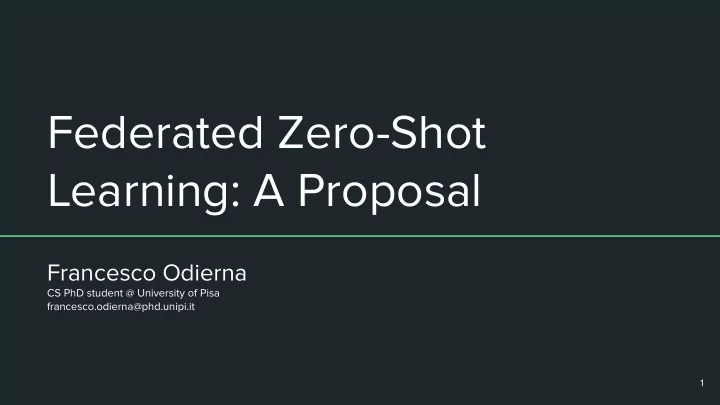

Federated Zero-Shot Learning: A Proposal Francesco Odierna CS PhD student @ University of Pisa francesco.odierna@phd.unipi.it 1
Outline ● Introduction ○ Federated Learning ○ Zero-Shot Learning ● The Proposal ● Motivation ● Road Map 2
Federated Learning 3
Federated Learning (1) Primary goal Training a global shared model. How? Using data stored locally on remote devices. Why? Decentralization. Privacy preserving. Model adaptation. 4
Federated Learning (2) Problem formulation Goal 5
Federated Learning (3) Steps A. Local updates. B. Models aggregation. C. Global model distribution. 6
Federated Learning (4) Key challenges 1. Expensive communication 3. Privacy ○ Updates may become a bottleneck. ○ Updates may reveal sensitive information. ○ Communication-efficient methods are ○ Trade-off between performance and necessary. privacy. 2. Systems heterogeneity 4. Statistical heterogeneity ○ High hardware variability. ○ Each device generates its own data. ○ Low amount of participation. ○ Multi-task learning and meta-learning ○ Strategies to deal with HW heterogeneity. approaches. 7
Zero-Shot Learning 8
Zero-Shot Learning (1) Primary goal Learn to classify unseen testing examples without training data. How? Using additional knowledge: a semantic space . Why? Learning with few data. Adaptation to new unseen categories. Deal with a variable number of categories. 9
Zero-Shot Learning (2) Problem formulation Goal 10
Zero-Shot Learning (3) 11
Zero-Shot Learning (4) Key challenges 1. Extend ZSL to different type of data. ○ Most of the works focus on images. 2. Exploit characteristics of input data. ○ Time-series, for example. 3. Combination with other learning paradigms. Why not Federated Learning? ○ 12
Federated Zero-Shot Learning 13
Federated Zero-Shot Learning (1) The proposal Federate Learning + Zero-Shot Learning. Motivation Real world conditions ≠ Lab conditions. ● Few labeled data. Unseen classes. ● ● Data distributed across devices. GDPR regulation. ● A novel paradigm is needed! 14
Federated Zero-Shot Learning (2) Features 1. Learning with few labeled data. ○ Collaboration to enhance the global model. ○ ZSL to deal with unseen classes. 2. Privacy. ○ Training on remote devices. 3. Human Centric AI. ○ Local data. ○ Human feedback. ○ User-based model → Services personalization. 15
Road Map 16
Road Map Goal Federated Learning + Zero-Shot Learning → Services Personalization. Models & Data Recurrent models on sequential data e.g. time-series. Challenges 1. Train recurrent models in FL scenarios. ○ Communication, privacy, new learning algorithms. 2. ZSL with time-series data. Semantic space. ○ 3. Incorporate human feedbacks during the training. 4. Put it all together! 17
References 1. H.T. Cheng, M. Griss, P. Davis, J. Li, and D. You, “Towards zero-shot learning for human activity recognition using semantic attribute sequence model” , in Proceedings of the 2013 ACM international joint conference on Pervasive and ubiquitous computing. 2. V. Smith, C.K. Chiang, M. Sanjabi, and A. S. Talwalkar, “ Federated Multi-Task Learning” , in Advances in Neural Information Processing Systems 30, 2017. 3. H. B. McMahan, E. Moore, D. Ramage, S. Hampson, and B. A. y Arcas, “Communication-Efficient Learning of Deep Networks from Decentralized Data” , arXiv:1602.05629, Feb. 2017, http://arxiv.org/abs/1602.05629. 4. W. Wang, V. W. Zheng, H. Yu, and C. Miao, “A Survey of Zero-Shot Learning: Settings, Methods, and Applications” , ACM Trans. Intell. Syst. Technol., vol. 10, no. 2, pp. 1–37, Jan. 2019. 5. Q. Yang, Y. Liu, T. Chen, and Y. Tong, “Federated Machine Learning: Concept and Applications” , ACM Trans. Intell. Syst. Technol., vol. 10, no. 2, pp. 1–19, Jan. 2019. 6. T. Li, A. K. Sahu, A. Talwalkar, and V. Smith, “Federated Learning: Challenges, Methods, and Future Directions” , arXiv:1908.07873, Aug. 2019, http://arxiv.org/abs/1908.07873. 18
Questions? Francesco Odierna CS PhD student @ University of Pisa francesco.odierna@phd.unipi.it 19
Recommend
More recommend